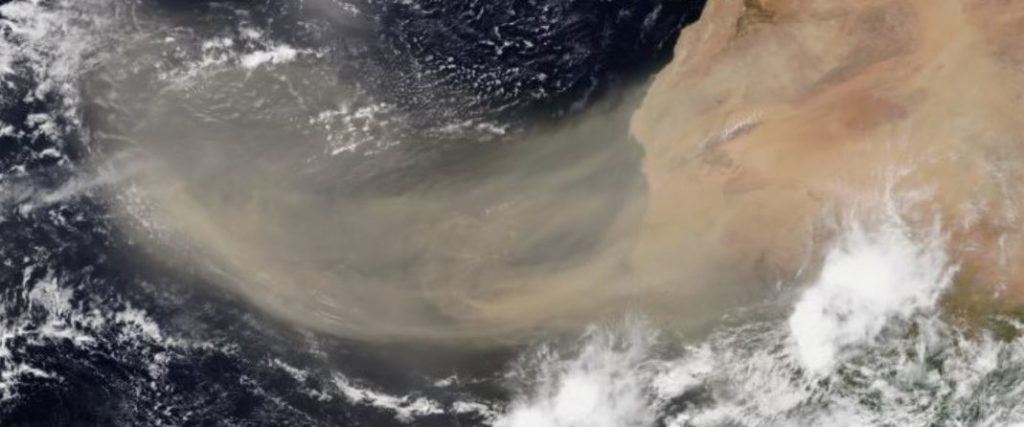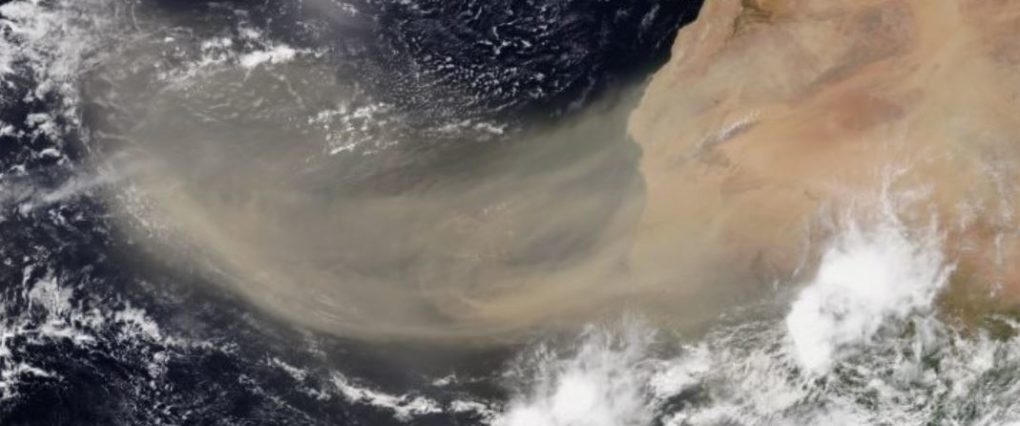“Godzilla Dust Cloud” from Sahara Slams the US, Southern Cities Face Hazardous Air Quality
 By Elias Marat
By Elias Marat
As if 2020 hasn’t been apocalyptic enough with war, fires, plagues, and locusts – now the U.S. will literally be having its breath taken away by a mammoth cloud of dust floating in from overseas.
The vast cloud of Sahara dust that blanketed the Caribbean, causing “hazardous” air quality levels for the islands, slammed into the U.S. for the first time on Thursday.
The gigantic plumes of dust, which have been captured in dramatic satellite images, hit Mississippi’s Gulf Coast after churning across thousands of miles from the African desert, reports Jackson-based WJTV.
The dust plumes, which have been nicknamed the “Godzilla Dust Cloud” by some experts, have also begun blanketing Florida, reports Fox 35.
Widget not in any sidebars
The cloud is also expected to blanket parts of Louisiana, Alabama, and Texas.
On Friday afternoon, social media users began posting images of downtown Austin, Dallas and Houston skylines being totally obscured by the particulate matter from the Sahara.
#SaharanDust This is downtown Austin, TX right now. That’s about 3-4 hours south of the Dallas area. pic.twitter.com/8Hl8LMcjdL
— 😷😷🇺🇸˜”*°•. 🔴 Kato Justus⁴ 🔴.•°*”˜🇺🇸😷😷 (@KatoJustus4) June 26, 2020
The dust is here, wow! Welcome to Houston, Sahara Desert. The dust may mitigate some of the expected rain showers this afternoon, too. #KHOU11 pic.twitter.com/QFDQ2mWuiY
— Blake Mathews (@KHOUBlake11) June 26, 2020
The Dallas skyline is seen through hazy skies as a dust plume, which traveled from the Sahara Desert across the Atlantic Ocean, arrives in North Texas on Friday, June 26, 2020 in Dallas. // Photo by Ryan Michalesko, @dallasnews https://t.co/3IbrNrkXjp pic.twitter.com/AqJLUup0KP
— Ryan Michalesko (@photosbylesko) June 26, 2020
“The Saharan dust will overtake entire states,” said meteorologist Tyler Mauldin of CNN. “Even southern Illinois and Ohio may get into the mix. That’s how far north it could get pulled up.”
While the Saharan dust clouds are likely to result in some gorgeous sunrises and sunsets, the phenomenon also coincides with a dramatic uptick in coronavirus infections in the region.
“The main impacts of the Saharan dust will be hazy skies during the day, locally reduced visibility and degraded air quality,” the Weather Prediction Center said. “However, this will also make for some very colorful sunrises and sunsets with deeper oranges and reds compared to normal.”
The mass of dry and extremely dusty air is known as the Saharan Air Layer or SAL and forms over the Sahara desert before moving across the North Atlantic during the late spring to early autumn, typically peaking from late June to mid-August, according to the US National Oceanic and Atmospheric Administration (NOAA). The layer can be up to 3 kilometers (1.86 miles) thick.
When you ask yourself what more can 2020 bring then #SaharanDust answers your question. pic.twitter.com/r6paU5j4gG
— cafesinleche (@cafesinleche) June 26, 2020
However, this year’s Saharan dust cloud is larger than anything that’s been seen in half a century.
“While it’s normal for Saharan dust to reach the U.S. every hurricane season, this event is unprecedented in thickness and coverage,” Mauldin says.
Health specialists are expressing alarm about the complications that the dust cloud could cause for those already struggling with respiratory symptoms tied to the COVID-19 pandemic. According to Pablo Méndez Lázaro, an environmental health specialist at the University of Puerto Rico, the concentration was so high in the Caribbean – darkening skies and reducing visibility greatly – that it even had an impact on people who are relatively healthy.
“This is the most significant event in the past 50 years,” Lázaro told Associated Press. “Conditions are dangerous in many Caribbean islands.”
While Dr. Elizabeth Matsui, a pediatric allergist and epidemiologist at UT’s Dell Medical School, believes that the dust cloud could impact the spread and the deadliness of COVID-19.
“If you live in an area where potentially you’re getting more inflammation in your lungs from the Saharan dust, then you’re also exposed to COVID, it may set you up to be more susceptible to either getting the infection or for having more severe consequences of getting the infection,” Matsui said. However, she added that it could merely lead to coronavirus-style symptoms even if you don’t have the disease.
Saharan dust is now moving through much of the South. Brighter sunsets are ahead, but watch out for lower air quality: https://t.co/PQW8IyIb6o pic.twitter.com/bUqgBYYPln
— The Weather Channel (@weatherchannel) June 26, 2020
On the positive side, however, the Saharan dust layer could mean that the looming hurricane season is unlikely to occur. After all, hurricanes rely on hot, humid, and calm environments to form – something made impossible by the extremely dry air brought about by the Saharan Air Layer.
“The dust is the visible part of the reduced tropical development potential area,” meteorologist Chad Myers said. “It is the dry air and additional vertical wind shear along with the dust that are the driving factors in limiting tropical storm development.”
However, residents of the U.S. South should likely take heed of their Caribbean neighbors who wore double masks to limit their exposure to both the coronavirus and the mammoth dust plumes.
“Some of this dust will settle to ground level,” Myers said. “People should monitor their local air quality and possibly limit outdoor exposure.”
Yo, this #SaharanDust is no joke. pic.twitter.com/yZQZBOCsuV
— The Bear Jieux (@TheBearJieux) June 25, 2020
Source: The Mind Unleashed
Subscribe for natural health news to your inbox. Follow Natural Blaze on YouTube, Twitter and Facebook. Become a Patron for as little as $1 per month.



